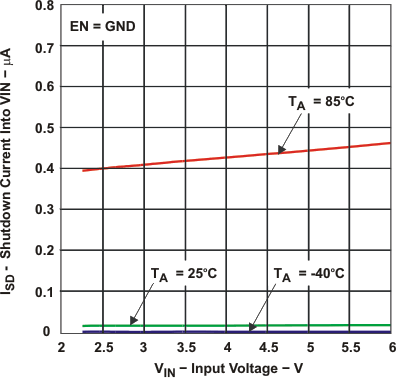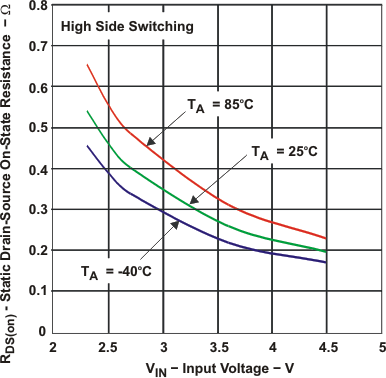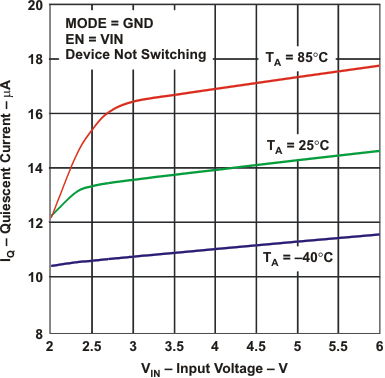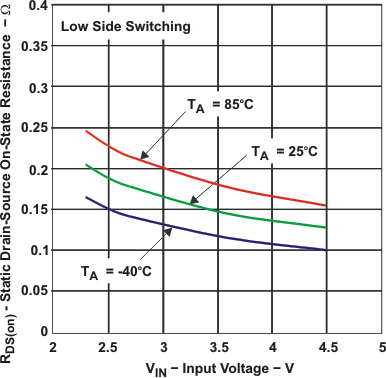SLVSB38C March 2011 – August 2016 TPS62242-Q1
PRODUCTION DATA.
- 1 Features
- 2 Applications
- 3 Description
- 4 Revision History
- 5 Pin Configuration and Functions
- 6 Specifications
- 7 Parameter Measurement Information
- 8 Detailed Description
- 9 Application and Implementation
- 10Power Supply Recommendations
- 11Layout
- 12Device and Documentation Support
- 13Mechanical, Packaging, and Orderable Information
Package Options
Mechanical Data (Package|Pins)
- DDC|5
Thermal pad, mechanical data (Package|Pins)
Orderable Information
6 Specifications
6.1 Absolute Maximum Ratings
over operating free-air temperature range (unless otherwise noted)(1)| MIN | MAX | UNIT | |||
|---|---|---|---|---|---|
| VI | Input voltage(2) | –0.3 | 7 | V | |
| Voltage at EN | –0.3 | VIN + 0.3, ≤7 | V | ||
| Voltage on SW | –0.3 | 7 | V | ||
| Peak output current | Internally limited | A | |||
| TJ | Maximum operating junction temperature | –40 | 150 | °C | |
| Tstg | Storage temperature | –65 | 150 | °C | |
(1) Stresses beyond those listed under Absolute Maximum Ratings may cause permanent damage to the device. These are stress ratings only, which do not imply functional operation of the device at these or any other conditions beyond those indicated under Recommended Operating Conditions. Exposure to absolute-maximum-rated conditions for extended periods may affect device reliability.
6.2 ESD Ratings
| VALUE | UNIT | |||
|---|---|---|---|---|
| V(ESD) | Electrostatic discharge | Human-body model (HBM), per AEC Q100-002(1) | ±2000 | V |
| Charged-device model (CDM), per AEC Q100-011 | ±750 | |||
(1) AEC Q100-002 indicates that HBM stressing shall be in accordance with the ANSI/ESDA/JEDEC JS-001 specification.
6.3 Recommended Operating Conditions
over operating free-air temperature range (unless otherwise noted)| MIN | MAX | UNIT | ||
|---|---|---|---|---|
| VI | Supply voltage, VIN | 2 | 6 | V |
| L | Inductance | 1.5 | 4.7 | µH |
| COUT | Output capacitance | 4.7 | 10 | µF |
| TA | Operating ambient temperature | –40 | 115 | °C |
| TJ | Operating junction temperature | –40 | 125 | °C |
6.4 Thermal Information
| THERMAL METRIC(1) | TPS62242-Q1 | UNIT | |
|---|---|---|---|
| DDC (SOT) | |||
| 5 PINS | |||
| RθJA | Junction-to-ambient thermal resistance | 193.7 | °C/W |
| RθJC(top) | Junction-to-case (top) thermal resistance | 40.7 | °C/W |
| RθJB | Junction-to-board thermal resistance | 35 | °C/W |
| ψJT | Junction-to-top characterization parameter | 0.9 | °C/W |
| ψJB | Junction-to-board characterization parameter | 34.7 | °C/W |
| RθJC(bot) | Junction-to-case (bottom) thermal resistance | N/A | °C/W |
(1) For more information about traditional and new thermal metrics, see the Semiconductor and IC Package Thermal Metrics application report.
6.5 Electrical Characteristics
Over full operating ambient temperature range, typical values are at TA = 25°C. Unless otherwise noted, specifications apply for condition VIN = EN = 3.6 V. External components CIN = 4.7 μF 0603, COUT = 10 μF 0603, L = 2.2 μH, refer to parameter measurement information.| PARAMETER | TEST CONDITIONS | MIN | TYP | MAX | UNIT | |
|---|---|---|---|---|---|---|
| SUPPLY | ||||||
| VIN | Input voltage range | 2 | 6 | V | ||
| IOUT | Output current | 2.3 V ≤ VIN ≤ 6 V | 300 | mA | ||
| 2 V ≤ VIN ≤ 2.3 V | 150 | |||||
| IQ | Operating quiescent current | IOUT = 0 mA. Pulse frequency modulation (PFM) mode enabled, device not switching | 15 | μA | ||
| IOUT = 0 mA. PFM mode enabled, device switching, VOUT = 1.2 V (1) | 18.5 | |||||
| IOUT = 0 mA, switching with no load, PWM operation, VOUT = 1.2 V, VIN = 3 V | 3.8 | mA | ||||
| ISD | Shutdown current | EN = GND, TA = 25°C | 0.1 | 1 | μA | |
| EN = GND, TA = –40°C to 115°C | 5 | µA | ||||
| UVLO | Undervoltage lockout threshold | Falling | 1.85 | V | ||
| Rising | 1.95 | |||||
| ENABLE, MODE | ||||||
| VIH | High-level input voltage, EN | 2 V ≤ VIN ≤ 6 V | 1 | VIN | V | |
| VIL | Low-level input voltage, EN | 2 V ≤ VIN ≤ 6 V, TA = 25°C | 0 | 0.4 | V | |
| 2 V ≤ VIN ≤ 6 V , TA = –40°C to 115°C | 0.35 | V | ||||
| IIN | Input bias current, EN | EN, MODE = GND or VIN | 0.01 | 1 | μA | |
| POWER SWITCH | ||||||
| RDS(on) | High-side MOSFET ON-resistance | VIN = VGS = 3.6 V, TA = 25°C | 240 | 480 | mΩ | |
| Low-side MOSFET ON-resistance | 180 | 380 | ||||
| ILIMF | Forward current limit MOSFET high-side and low-side | VIN = VGS = 3.6 V, TA= 25°C | 0.56 | 0.7 | 0.84 | A |
| VIN = VGS = 3.6 V, TA = –40°C to 115°C | 0.54 | 0.95 | ||||
| TSD | Thermal shutdown | Increasing junction temperature | 135 | 150 | 165 | °C |
| Thermal shutdown hysteresis | Decreasing junction temperature | 12 | 14 | 16 | °C | |
| OSCILLATOR | ||||||
| ƒSW | Oscillator frequency | 2 V ≤ VIN ≤ 6 V | 2 | 2.25 | 2.5 | MHz |
| OUTPUT | ||||||
| VOUT | Output voltage | 1.2 | V | |||
| VREF | Reference voltage | TA = 25°C | 594 | 600 | 606 | mV |
| VFB | Feedback voltage | PWM operation, 2 V ≤ VIN ≤ 6 V, in fixed output voltage versions VFB = VOUT, See (3) ,TA = 25°C |
–1.5% | 0% | 1.5% | |
| PWM operation, 2 V ≤ VIN ≤ 6 V, in fixed output voltage versions VFB = VOUT, See (3) ,TA = –40°C to 115°C | –1.5% | 2.5% | ||||
| Feedback voltage PFM mode | Device in PFM mode | 0% | ||||
| Load regulation | PWM mode | –0.5 | %/A | |||
| tStart up | Start-up time | Time from active EN to reach 95% of VOUT nominal | 500 | μs | ||
| tRamp | VOUT ramp UP time | Time to ramp from 5% to 95% of VOUT | 250 | μs | ||
| Ilkg | Leakage current into SW pin | VIN = 3.6 V, VIN = VOUT = VSW, EN = GND,(2) , TA = 25°C |
0.1 | 1 | μA | |
| VIN = 3.6 V, VIN = VOUT = VSW, EN = GND, (2), TA = –40°C to 115°C |
10 | |||||
(1) See the parameter measurement information.
6.6 Typical Characteristics
Table 1. Table of Graphs
| FIGURE | ||
|---|---|---|
| Shutdown Current into VIN | vs Input Voltage, (TA = 85°C, TA = 25°C, TA = –40°C) | Figure 1 |
| Quiescent Current | vs Input Voltage, (TA = 85°C, TA = 25°C, TA = –40°C) | Figure 2 |
| Static Drain-Source On-State Resistance | vs Input Voltage, (TA = 85°C, TA = 25°C, TA = –40°C) | Figure 3 |
| Figure 4 | ||
 Figure 1. Shutdown Current Into VIN vs Input Voltage
Figure 1. Shutdown Current Into VIN vs Input Voltage
 Figure 3. Static Drain-Source On-State Resistance
Figure 3. Static Drain-Source On-State Resistancevs Input Voltage
 Figure 2. Quiescent Current vs Input Voltage
Figure 2. Quiescent Current vs Input Voltage
 Figure 4. Static Drain-Source On-State Resistance
Figure 4. Static Drain-Source On-State Resistancevs Input Voltage